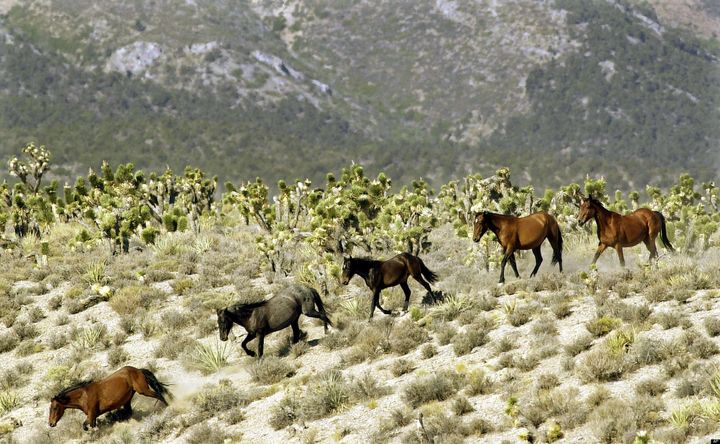
When I think of horses, I think of my alma mater, Saint Timothy's school in the suburbs of Baltimore Maryland. One of the most memorable sights from my high school days was that of my fellow classmates preparing for horse shows, braiding their beautiful horses and donning their riding outfits in hopes of a victory: win, place, or show. Horses, we learned there, are magnificent and sacred animals that we cared for and nourished.
Likewise, when we think of the West Coast of the United States, places like Wyoming, Nevada, and Utah, we immediately think of horses running free wild mustangs roaming and surveying, in their magnificent elegance, the vast open lands and stunning sunsets. It's the legendary stuff of movie classics and television shows; bold survivors of harsh lands, these free horses mirror our own freedom and survival instincts.
But in Wyoming, there is a drive to slaughter horses that have outlived their usefulness or are considered to be over populated in that State. "There has been a tripling in the number of abandoned horses every year for the past three years," said Sue Wallis, a Wyoming state representative and executive director of the UOH (The United Organizations of the Horse). To this end, Wyoming Governor Dave Freudenthal signed HB 122 into law March 9, 2010, which allows horses to be sent to slaughter as livestock (akin to cattle and sheep). The law provides the Wyoming Board of Livestock with three options to deal with abandoned, stray, feral or abused animals which enter into their jurisdiction. The Board may take the animal to public sale, which was the only option prior to this legislation, or may now send the animal to slaughter or destroy the animal.
Representative Wallis wants to build a slaughterhouse; but it is suspected that Wallis stands to profit as UOH executive director from the proposed slaughterhouse. "This project will cost millions of dollars," Wallis said, "but there is quite a lot of government financial help available from rural development funds, plus money from wealthy private investors in the horse industry." And Wallis would like to see an additional six equine slaughterhouses within the United States. She suggests that the meat could be used within a state in publicly financed institutions like prisons, schools, nursing homes and "for the needy."
But is Wallis's plan to stun the horses in the head and then slaughter them humane? Many in the State believe that it is not. One Wyoming resident says, "It is my understanding that horses do wake up from this "stunning" and are conscious as they are gutted." Scott Beckstead, an equine protection specialist for the Humane Society of the United States, believes that slaughtering horses can never be humane.
"[Horses] are extreme flight animals. When they enter the kill box, they become very agitated, making it near (sic.) impossible to execute a humane kill. It is a major betrayal to our horses. We would never slaughter our cats and dogs."
Successful efforts were made to prevent the slaughter of west coast horses in Nevada this summer, where U.S. Bureau of Land Management (BLM), sought to round up the horses for slaughter. Thousands of horses were saved. Presently in Congress there are bi partisan bills for the prevention of the slaughter of horses. The Senate bill was introduced March 26, 2009 by Senator Mary Landrieu (D-LA) and Senator John Ensign (R-NV). The Prevention of Equine Cruelty Act (S. 727). The bill is a companion to HR 503 the Prevention of Equine Cruelty Act of 2009, re- introduced by Congressman John Conyers Jr. (D-MI), Representative Dan Burton (R-IN) and others. The Senate bill was referred to committee as of June 2010, but no word on its passage on either bill. As this seems to be one of the few bi-partisan actions of this Congress seemingly the bill should gallop to passage.
Wallis anticipates approximately 6 months for her slaughterhouse plan to come to fruition. When I remember my high school days and the beautiful equestrian events, I never thought of their wilder free roaming cousins as kill box victims soon to be dinner. We encourage the Senate and House to urgently pass the Prevention of Equine Cruelty Act.